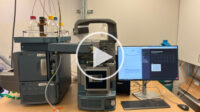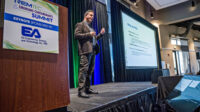Academics, consultants collaborate to address PFAS challenges at RemTEC & EC Tuesday keynote
New technologies are coming to market that destroy PFAS, speakers say. But implementation challenges remain.
.jpg?1664910248)
Photo by Jon Phillips
Remediating groundwater to the point where you can drink it safely is becoming more challenging for water treatment districts, as various states raise regulatory targets for per- and polyfluoroalkyl substances, or PFAS. The patchwork of inconsistent targets add to other more technical challenges when it comes to implementing PFAS-targeting technology at a large scale, say the first keynote presenters of the RemTEC and Emerging Contaminants Summit in Westminster on Oct. 4.
In the states where the targets are voluntary, like Illinois, townships with known PFAS issues like Freeport have installed new equipment to lower concentrations to acceptable levels, anticipating they’ll be required to do so eventually when interest rates are less advantageous – either at the state level, or through long-awaited maximum contaminant levels (MCLs) from the EPA on PFAS. Freeport is an outlier though, and there remain glaring issues like PFAS contamination in rainwater around the world and high-concentration areas like the Great Lakes region.
“We can't treat all the soil and all the water. It's just not feasible to get down to those levels for soil and water around the globe,” says Colorado School of Mines Professor Chris Higgins, speaking at the first keynote address at the RemTEC and EC Summit. “What do we prioritize? How do we approach this? And I think to answer those questions, we have to do a thoughtful analysis of where the contamination is, where are the real risks? And to do that, we have to understand the complexities of the problem."
Of the available technologies, speaker Rula Deeb says there’s several ways to destroy PFAS. But to achieve removal rates like 99.999% using treatment train followed up by more disruptive approaches, Higgins adds it likely isn’t going to be realistic after a cost-benefit analysis.
“We don't fully understand the cost and performance of a lot of these innovative technologies when it comes to full scale up,” says Deeb, who in addition to serving as a RemTEC conference chair with Higgins, is a senior principal civil and environmental engineer at Geosyntec Consultants.
“We also don't have side-by-side comparisons of the different technologies and we don't fully appreciate how some of the technologies would behave at different sites with different groundwater or wastewater matrices,” she says, adding conferences like RemTEC and Emerging Contaminants Summit are a venue for academia and industry to collaborate on bridging these gaps.
Higgins concludes that, as evidenced by California’s recent ban on PFAS in makeup, the source of exposure in sources other than drinking water is gaining prominence.
"Some exposures are going to be more important in different situations," Higgins says, previewing a keynote by Joseph Braun of Brown University scheduled for the last day of the show.
To stay up to date on coverage of the show, and analysis thereafter, subscribe to the Remediation Technology Insider newsletter.




